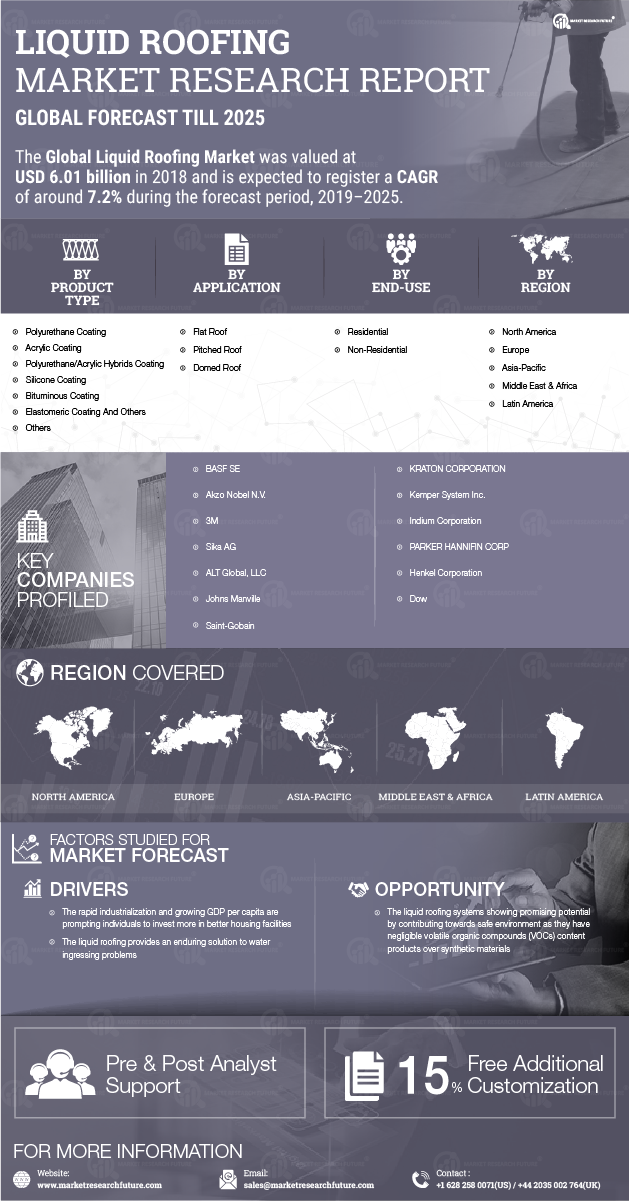Growth in Construction Activities
The resurgence of construction activities across various sectors is propelling the Liquid Roofing Market. With urbanization and infrastructure development on the rise, there is a heightened demand for durable and efficient roofing solutions. Liquid roofing systems, which offer seamless application and excellent waterproofing capabilities, are increasingly preferred in both residential and commercial projects. Recent statistics suggest that the construction sector is expected to expand by 5% annually, further driving the need for innovative roofing solutions. This growth presents a significant opportunity for liquid roofing manufacturers to capture market share and meet the evolving demands of the construction industry.
Advancements in Material Technology
Technological innovations in material science are transforming the Liquid Roofing Market. The development of advanced polymers and coatings has led to the creation of liquid roofing systems that are more durable, flexible, and resistant to environmental stressors. These advancements not only enhance the performance of liquid roofing solutions but also extend their lifespan, making them a cost-effective choice for consumers. The introduction of eco-friendly materials is also noteworthy, as it aligns with the growing sustainability trends in construction. As these technologies continue to evolve, they are likely to drive further adoption of liquid roofing systems in various applications.
Rising Demand for Energy Efficiency
The increasing emphasis on energy efficiency in construction is a pivotal driver for the Liquid Roofing Market. As building owners and developers seek to reduce energy consumption, liquid roofing systems, known for their superior insulation properties, are gaining traction. These systems can significantly lower heating and cooling costs, making them an attractive option. According to recent data, the energy-efficient roofing segment is projected to grow at a compound annual growth rate of approximately 7% over the next five years. This trend indicates a robust market potential for liquid roofing solutions that contribute to sustainability and cost savings, thereby enhancing their appeal in the Liquid Roofing Market.
Regulatory Support for Sustainable Practices
Regulatory frameworks promoting sustainable building practices are influencing the Liquid Roofing Market. Governments and regulatory bodies are implementing stringent guidelines aimed at reducing carbon footprints and enhancing energy efficiency in construction. These regulations often encourage the use of liquid roofing systems, which are recognized for their environmental benefits. As a result, manufacturers are increasingly aligning their products with these regulations to gain a competitive edge. The anticipated growth in the sustainable construction sector, projected at 8% over the next few years, suggests a favorable environment for liquid roofing solutions that comply with emerging standards.
Increased Awareness of Waterproofing Solutions
The heightened awareness regarding the importance of waterproofing in building maintenance is a significant driver for the Liquid Roofing Market. Property owners are increasingly recognizing the risks associated with water damage, leading to a surge in demand for effective waterproofing solutions. Liquid roofing systems, known for their seamless application and excellent waterproofing properties, are becoming a preferred choice. Market analysis indicates that the waterproofing segment is expected to grow by 6% annually, reflecting the increasing investment in building protection. This trend underscores the potential for liquid roofing solutions to address the critical need for reliable waterproofing in various construction projects.













Leave a Comment